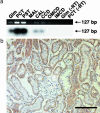Isolation and characterization of a digoxin transporter and its rat homologue expressed in the kidney
- PMID: 14993604
- PMCID: PMC373503
- DOI: 10.1073/pnas.0304987101
Isolation and characterization of a digoxin transporter and its rat homologue expressed in the kidney
Abstract
Digoxin, which is one of the most commonly prescribed drugs for the treatment of heart failure, is mainly eliminated from the circulation by the kidney. P-glycoprotein is well characterized as a digoxin pump at the apical membrane of the nephron. However, little is known about the transport mechanism at the basolateral membrane. We have isolated an organic anion transporter (OATP4C1) from human kidney. Human OATP4C1 is the first member of the organic anion transporting polypeptide (OATP) family expressed in human kidney. The isolated cDNA encodes a polypeptide of 724 aa with 12 transmembrane domains. The genomic organization consists of 13 exons located on chromosome 5q21. Its rat counterpart, Oatp4c1, is also isolated from rat kidney. Human OATP4C1 transports cardiac glycosides (digoxin, K(m) = 7.8 microM and ouabain, K(m) = 0.38 microM), thyroid hormone (triiodothyronine, K(m) = 5.9 microM and thyroxine), cAMP, and methotrexate in a sodium-independent manner. Rat Oatp4c1 also transports digoxin (K(m) = 8.0 microM) and triiodothyronine (K(m) = 1.9 microM). Immunohistochemical analysis reveals that rat Oatp4c1 protein is localized at the basolateral membrane of the proximal tubule cell in the kidney. These data suggest that human OATP4C1/rat Oatp4c1 might be a first step of the transport pathway of digoxin and various compounds into urine in the kidney.
Figures








References
-
- The Digitalis Investigation Group (1997) N. Engl. J. Med. 336, 525-533. - PubMed
-
- Koren, G. (1987) Clin. Pharmacokinet. 13, 334-343. - PubMed
-
- Inui, K., Masuda, S. & Saito, H. (2000) Kidney Int. 58, 944-958. - PubMed
-
- Dresser, M. J., Leabman, M. K. & Giacomini, K. M. (2001) J. Pharm. Sci. 90, 397-421. - PubMed
-
- Woodland, C., Ito, S. & Koren, G. (1998) Ther. Drug Monit. 20, 134-138. - PubMed
Publication types
MeSH terms
Substances
Associated data
- Actions
- Actions
LinkOut - more resources
Full Text Sources
Other Literature Sources
Chemical Information
Molecular Biology Databases

